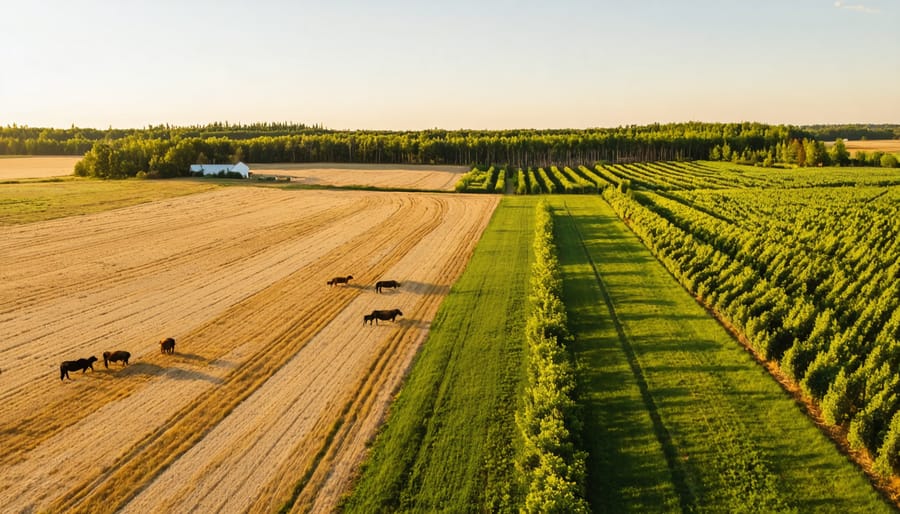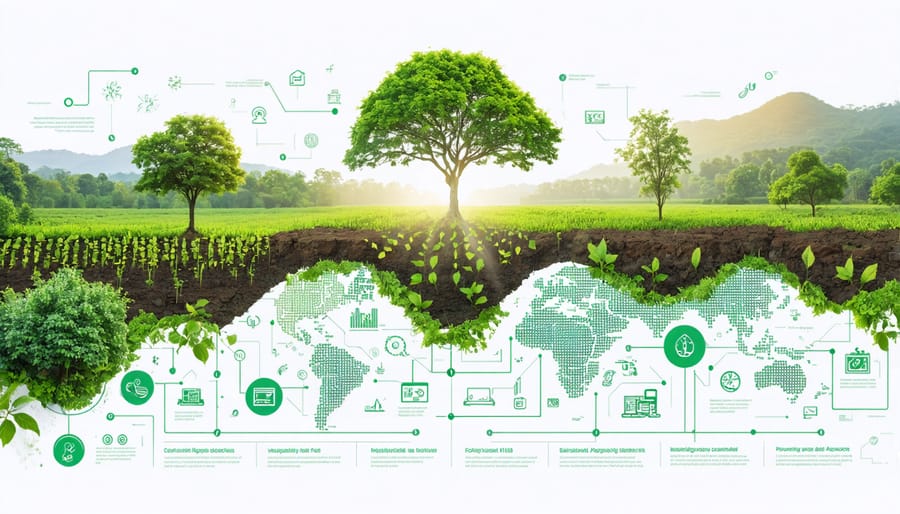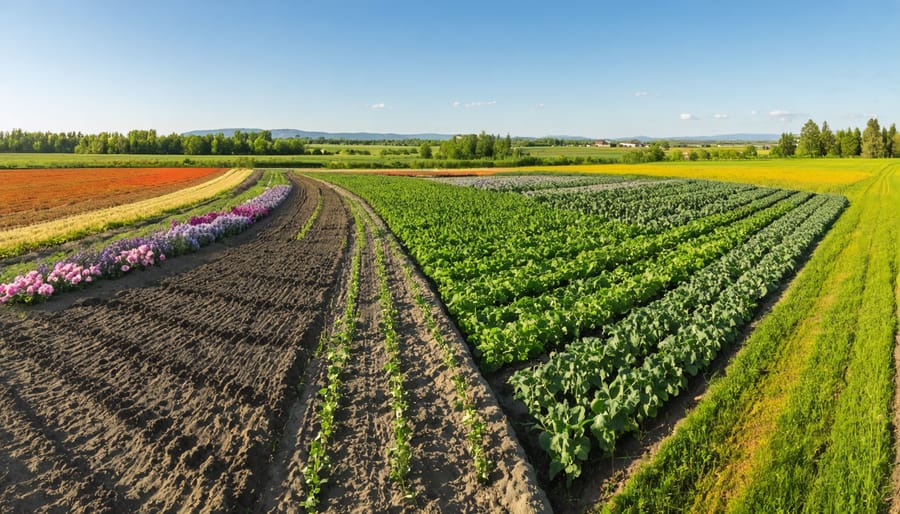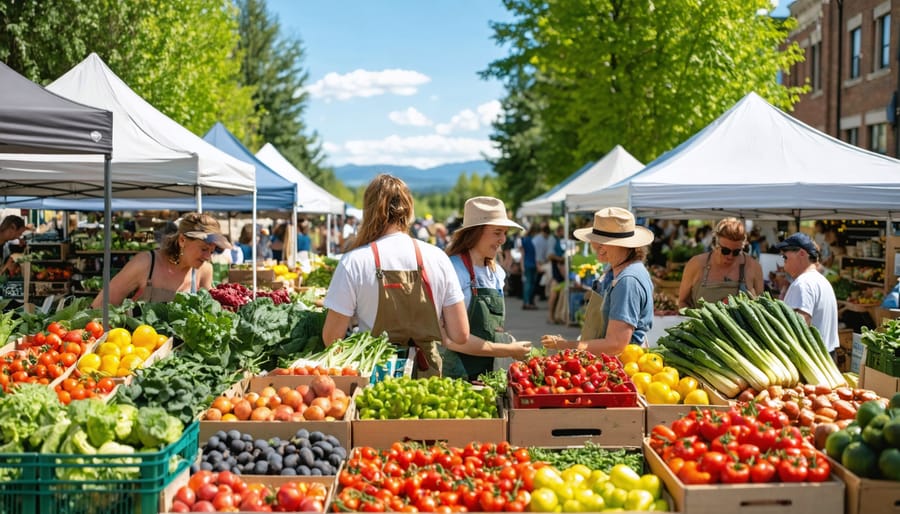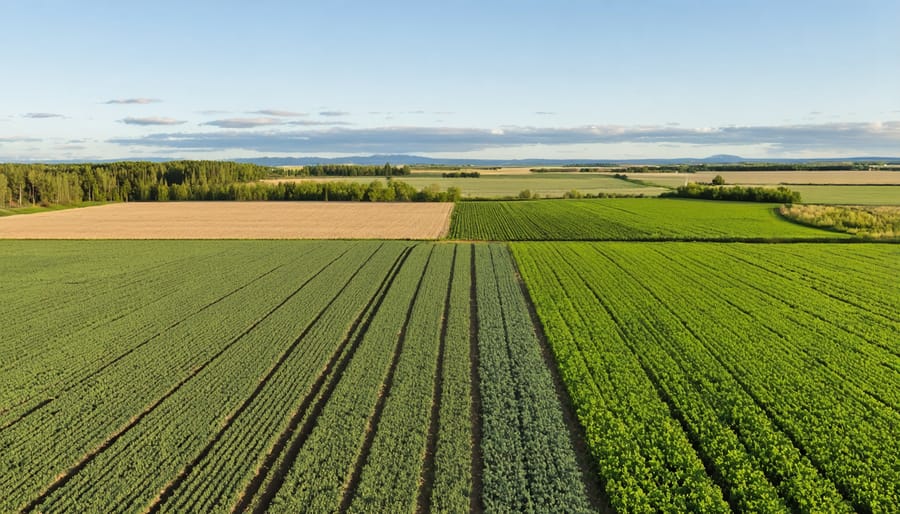Circular agriculture stands at the forefront of Canada’s agricultural evolution, transforming how we think about waste, resources, and farm productivity. Unlike traditional linear farming methods, this regenerative approach creates a closed-loop system where every output becomes a valuable input. On Alberta farms, innovative producers are already turning livestock manure into biogas energy, converting crop residues into soil amendments, and implementing precision irrigation systems that reduce water waste by up to 40%.
This integrated farming philosophy isn’t just environmentally sound—it’s economically vital. Canadian farmers adopting circular practices report up to 25% reduction in input costs while maintaining or improving yields. From small-scale market gardens in southern Alberta to large grain operations in the prairie provinces, circular agriculture is reshaping the landscape of Canadian farming.
By mimicking natural ecosystems where nothing goes to waste, circular agriculture offers a practical solution to pressing challenges like soil degradation, water scarcity, and rising input costs. It represents a return to traditional wisdom, enhanced by modern technology and data-driven decision-making. For Canadian farmers facing increasing pressure to produce more while protecting natural resources, circular agriculture isn’t just an option—it’s becoming an essential strategy for long-term success.
The Power of Circular Agriculture in Canadian Farming
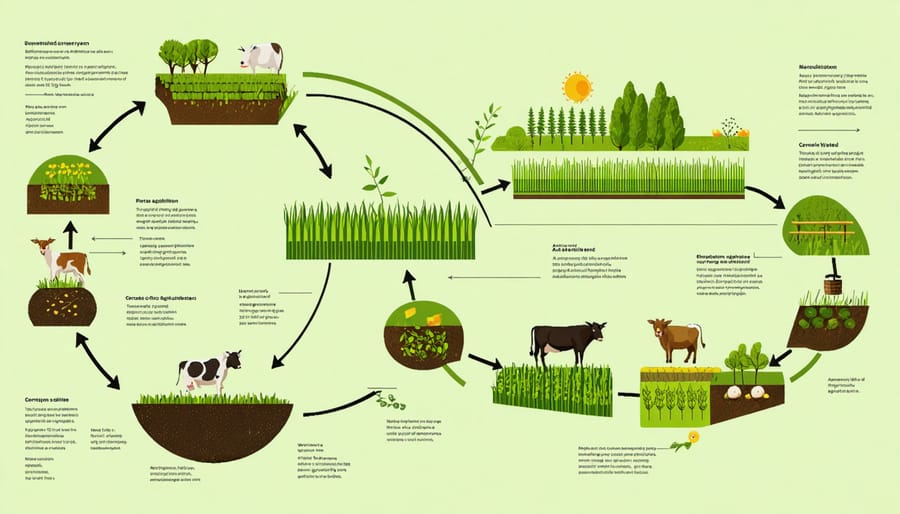
From Waste to Resource: The Circular Mindset
At the heart of circular agriculture lies a fundamental shift in how we view waste. Rather than seeing crop residues, animal manure, or processing byproducts as disposal challenges, circular thinking recognizes these materials as valuable resources waiting to be utilized. Here in Alberta, forward-thinking farmers are already transforming what was once considered waste into soil amendments, energy sources, and even new revenue streams.
This mindset shift requires us to look at our farms as interconnected systems rather than linear production chains. Every output becomes a potential input for another process. For instance, livestock manure becomes fertilizer for crops, while crop residues can feed livestock or generate biogas. Even processing waste from local food manufacturers can find new life as animal feed supplements.
The circular approach also encourages us to think beyond our farm gates. By connecting with neighbouring farms and local businesses, we can create regional resource loops that benefit the entire community. This collaborative approach not only reduces waste but also strengthens local agricultural networks and builds more resilient food systems.
Economic Benefits for Alberta Farmers
Implementing circular agriculture practices can significantly boost farm profits through multiple revenue streams and cost reductions. Alberta farmers who have adopted these methods report saving 30-40% on fertilizer costs by utilizing livestock manure and crop residues effectively. For example, the McGrath family farm near Lethbridge saves approximately $45,000 annually through their integrated livestock-crop system.
On-farm biogas production offers another substantial economic opportunity, with several Alberta operations generating $20,000-30,000 yearly from excess energy sales to the grid. Composting operations can create additional revenue streams, with premium compost products selling for $80-120 per tonne in local markets.
Water conservation methods inherent in circular agriculture typically reduce irrigation costs by 25%, while improved soil health leads to better crop resilience and reduced input costs. Many farmers also report increased market access through sustainability certifications, commanding premium prices for their products. The initial investment in circular systems often pays for itself within 2-3 growing seasons through combined savings and new income sources.
Practical Implementation Strategies
Crop Residue Management
Crop residue management represents a cornerstone of circular agriculture, turning what was once considered waste into valuable resources. Here in Alberta, innovative farmers are leading the way in sustainable residue management practices that benefit both their operations and the environment.
One successful approach is incorporating crop stubble back into the soil using conservation tillage methods. This practice enhances soil organic matter, improves water retention, and reduces erosion – particularly valuable during our prairie winds. Local farmer Tom Anderson from Lethbridge reports a 15% increase in soil organic matter after three years of implementing this technique.
Composting remains another effective strategy, with many Alberta farmers creating nutrient-rich amendments from crop residues mixed with livestock manure. This combination produces a balanced fertilizer that can reduce dependency on synthetic inputs by up to 30%.
Some progressive operations are exploring biogas production from crop residues. The Circular Farms Cooperative near Red Deer has established a community-scale biodigester that converts crop waste into renewable energy, powering several local farms while producing high-quality digestate for soil amendment.
Alternatively, crop residues can be processed into livestock feed supplements, particularly valuable during drought years. The University of Alberta’s Agricultural Research Station has developed guidelines for treating wheat and barley straw to improve its nutritional value for cattle.
Remember to consider your specific soil conditions and operational needs when choosing residue management strategies. Your local agricultural extension office can provide tailored advice for your situation.
Water Recycling Systems
Water recycling systems are becoming increasingly vital for Alberta farmers as we face more frequent dry spells and rising water costs. These systems capture, treat, and reuse water from various agricultural processes, creating a more sustainable and efficient farm operation.
A prime example comes from the Morrison Family Farm near Lacombe, where they’ve implemented a closed-loop irrigation system that captures rainwater and recycling greenhouse wastewater. “We’ve cut our water consumption by 40% since installing our recycling system,” shares Sarah Morrison, whose setup has become a model for other local farmers.
Key components of an effective water recycling system include collection ponds, filtration units, and distribution infrastructure. Many Alberta farmers are now using constructed wetlands as natural filtration systems, which not only clean water but also create wildlife habitat. Storage tanks and underground cisterns help maintain water supplies during dry periods, while modern sensors and automated systems ensure optimal water distribution.
For greenhouse operations, condensation recovery systems can recapture up to 80% of water released through plant transpiration. Treatment methods like UV sterilization and biological filtration ensure recycled water meets safety standards for crop irrigation.
Remember to start small and scale up gradually. Consider beginning with a simple rainwater harvesting system before investing in more complex recycling infrastructure. Local agricultural extension offices can provide guidance on grants and technical support for implementing water recycling systems.
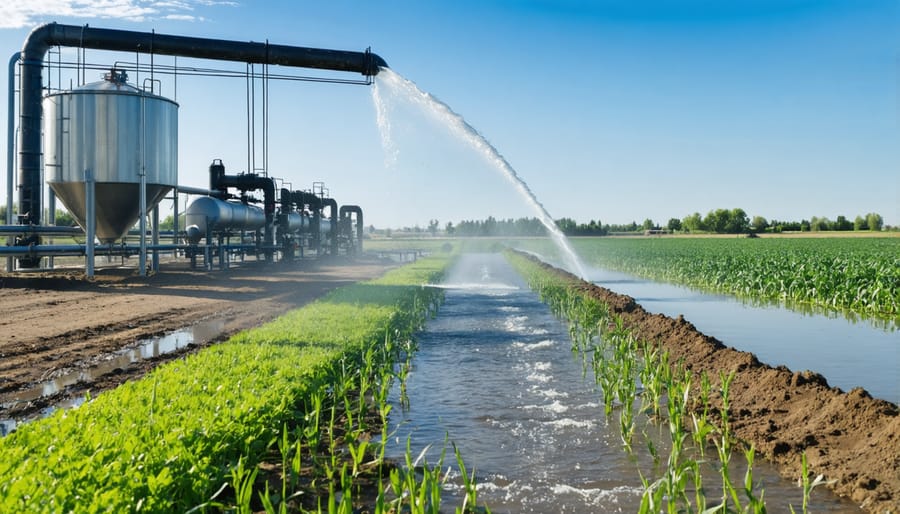
Nutrient Loop Closure
Maintaining soil fertility through nutrient loop closure is essential for sustainable farming practices. By implementing circular strategies, farmers can reduce dependency on external inputs while healing the land and improving long-term productivity.
One effective approach is integrating livestock and crop production systems. Manure from cattle operations can be composted and applied to crop fields, returning valuable nutrients to the soil. Alberta farmers have found success with rotational grazing systems that allow livestock to naturally distribute nutrients across pastures while improving soil structure.
Cover cropping plays a crucial role in nutrient cycling. Deep-rooted cover crops like alfalfa and clover can access nutrients from lower soil layers and make them available to subsequent crops. These plants also fix atmospheric nitrogen, reducing the need for synthetic fertilizers.
On-farm composting of crop residues and food processing waste creates nutrient-rich amendments while diverting organic materials from landfills. Many Canadian farmers are establishing partnerships with local food processors to acquire organic waste streams for composting.
Implementing buffer strips and wetland areas helps capture and filter nutrients that might otherwise be lost through runoff. These natural systems can be integrated into field margins and low-lying areas, supporting both nutrient retention and biodiversity.
Regular soil testing and careful nutrient budgeting ensure that farming practices maintain optimal nutrient levels while preventing excess accumulation or depletion.
Success Stories from Alberta’s Fields
The Thompson Family Farm Transformation
Located just outside of Red Deer, Alberta, the Thompson Family Farm has become a shining example of circular agriculture in action. In 2018, John and Sarah Thompson made the bold decision to transform their 800-hectare grain operation into a closed-loop system, focusing on minimizing waste and maximizing resource efficiency.
The Thompsons began by implementing crop rotation strategies that included nitrogen-fixing legumes, reducing their reliance on synthetic fertilizers by 40% within two years. They established partnerships with local livestock farmers to exchange crop residues for manure, creating a nutrient cycling system that benefits both operations.
A key innovation was their investment in an on-site composting facility, which processes agricultural waste into high-quality soil amendments. The facility now handles not only their own organic waste but also accepts green waste from neighbouring farms, generating an additional revenue stream.
The farm’s transformation included installing solar panels on their grain storage facilities and implementing precision agriculture technology to optimize water and input use. These changes resulted in a 30% reduction in operating costs and a 25% increase in soil organic matter levels over three years.
“The transition wasn’t always easy,” shares John Thompson, “but the long-term benefits to our soil health and bottom line have proven worth every challenge.” The farm now serves as a demonstration site for the Alberta Sustainable Agriculture Program, hosting regular field days for farmers interested in circular practices.
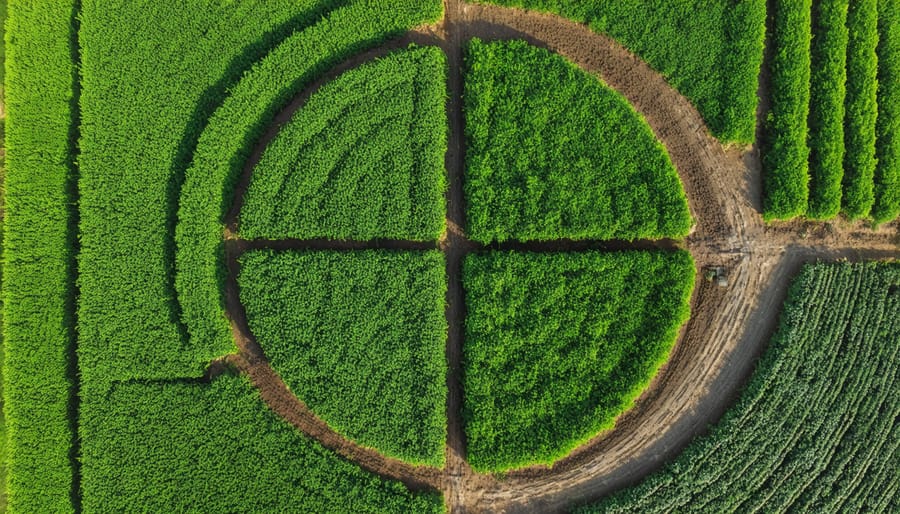
Community-Based Circular Solutions
In the heart of Alberta’s farming community, the Sustainable Farm Collective demonstrates how collaboration amplifies the impact of sustainable agricultural practices. This group of fifteen farms, ranging from small-scale vegetable operations to larger grain producers, has created a thriving circular system that benefits all participants.
The collective operates on a resource-sharing model where each farm contributes its unique outputs to benefit others. For instance, livestock farmers provide manure to crop producers, who in turn supply feed and bedding materials. A local dairy operation shares whey byproducts with pig farmers, while crop residues are processed into compost at a central facility.
What makes this initiative particularly successful is the establishment of a digital platform where members list their available resources and needs. This system has reduced waste by 40% across participating farms and decreased input costs by an average of 25% in the past two years.
The collective also partners with local food processors and restaurants, creating additional circular opportunities. Vegetable trim from processing facilities returns to farms as animal feed or compost, while restaurant food waste is converted into high-quality soil amendments through community composting programs.
This collaborative approach has not only improved soil health and reduced environmental impact but has also strengthened community bonds and economic resilience among participating farms.
Getting Started with Circular Agriculture
First Steps for Your Farm
Beginning your journey toward circular agriculture doesn’t have to be overwhelming. Start by conducting a thorough assessment of your current farming operations, identifying areas where waste is generated and resources are underutilized. This initial audit will help you spot immediate opportunities for implementing regenerative farming methods and circular practices.
Focus first on establishing a comprehensive composting system to transform organic waste into valuable soil amendments. Consider partnering with nearby farms or food processors to exchange resources and create local circular loops. For example, many Alberta dairy farmers are successfully collaborating with crop producers to utilize manure as fertilizer while receiving feed in return.
Next, implement water conservation strategies such as efficient irrigation systems and water recycling methods. Installing rain catchment systems can help reduce dependence on external water sources during dry periods. Consider introducing cover crops to protect soil during off-seasons and contribute to soil organic matter.
Document your current input costs, including feed, fertilizers, and energy usage. This baseline data will help you track improvements and identify areas where circular practices can reduce expenses. Remember to connect with local agricultural extension services and farmer networks – they often provide valuable guidance and may know of existing circular initiatives in your region that you can join.
Start small, measure your results, and gradually expand your circular practices as you gain confidence and experience.
Available Support and Resources
Canadian farmers looking to transition to circular agriculture practices have access to numerous support systems and funding opportunities. The Canadian Agricultural Partnership (CAP) offers grants and cost-sharing programs specifically designed for sustainable farming initiatives, with funding amounts ranging from $5,000 to $100,000 per project.
In Alberta, the Environmental Stewardship and Climate Change Producer Program provides financial assistance for farmers implementing circular practices. Agricultural service boards across the province offer free consultations with local experts who can help develop customized transition plans.
The Agricultural Research and Extension Council of Alberta (ARECA) connects farmers with demonstration farms and peer-to-peer learning opportunities. Their network includes experienced producers who have successfully implemented circular systems and are willing to share their expertise.
Technical support is available through Agriculture and Agri-Food Canada’s Living Labs initiative, where researchers work directly with farmers to test and implement circular solutions. Additionally, provincial agricultural colleges offer workshops and certification programs in sustainable farming practices.
For hands-on assistance, organizations like Young Agrarians and Organic Alberta provide mentorship programs and networking events. These groups can help connect new practitioners with experienced farmers who have already adopted circular methods.
Local agricultural extension offices maintain databases of qualified consultants and can direct farmers to relevant resources, including soil testing services and waste management specialists essential for circular system implementation.
Circular agriculture represents a transformative path forward for Canadian farming, offering practical solutions to some of our most pressing agricultural challenges. By embracing these sustainable practices, Alberta farmers can reduce waste, lower input costs, and create more resilient operations while contributing to environmental stewardship. The success stories from local farms demonstrate that circular agriculture isn’t just theoretical – it’s a viable approach that’s already working in our communities. As we face increasing pressure on our agricultural systems, the time to act is now. Whether you’re starting with simple composting or ready to implement comprehensive nutrient cycling, every step toward circularity matters. Connect with local agricultural extension services, join farmer-led initiatives, and explore available resources to begin your journey toward circular agriculture. Together, we can build a more sustainable and profitable future for Canadian farming.


